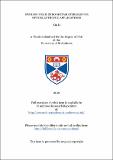Epsilon-near-zero metamaterials for optoelectronic applications
Abstract
My PhD is focused on the design, fabrication and optoelectronic applications of epsilon-near-zero
(ENZ) metamaterials (MMs), which have vanishing real part of the permittivity and
support fascinating optical effects, including light squeezing, sub-wavelength imaging, enhanced
directive emission and enhanced non-resonant optical nonlinearity. Different approaches have
been developed to realise ENZ media, such as tuning the modal dispersion in narrow plasmonic
channels, exploiting the natural dispersion of transparent conductive oxides and creating composite
structures with metals and dielectrics. As a platform with exotic physical properties, ENZ media
also exhibit enormous potentials in combination with tunability and various nanofeatures in the
photonic and plasmonic regimes.
This thesis demonstrates two approaches to achieve the ENZ condition. One method is to stack
metal (Ag) and dielectric (SiO2) layers periodically at sub-wavelength scales. The resulting material
behaves as an effective medium with an average permittivity close to zero, and we show that
this ENZ medium can enhance the emission of quantum dots. This approach generally requires
nanofabrication techniques developed for flat and rigid substrates, for example, the electron beam
evaporation, which are not always applicable to micro- and macroscopic devices with arbitrary
shapes. To surpass these limitations, we design and experimentally demonstrate an optical freestanding and low-loss ENZ membrane in the visible range, by layering polymer (SU-8) and Ag
nano-layers. Additionally, we propose a method to introduce both flexibility and electrical tunability
into ENZ media by replacing the metal layer with a 2D material, graphene, in the multilayer model.
The other way to obtain an ENZ response is using natural materials which operate in proximity
of their plasma frequency, typically here the indium tin oxide (ITO) at the near-infrared
range. The ITO thin films are deposited using radio frequency magnetron sputtering, and their
permittivities are manipulated via controlling fabrication parameters. We succeed in sweeping the
zero-permittivity frequency of ITO media by controlling the gas recipe and deposition temperature
during the sputtering process. To obtain specific optical responses, the ENZ ITO thin films are
designed to be combined with different photonic features, including nanoantenna on microsphere
and nanohelix, associated with a direct fabrication approach based on electron beam induced
deposition (EBID).
Furthermore, this thesis extends the research range by realising the photonic trimming of
quantum emitters via various metallic nanofeatures fabricated directly using EBID method. We
believe that the interaction of ENZ MMs with EBID approach offers an opportunity to create hybrid
ENZ platforms for optoelectronic applications.
Type
Thesis, PhD Doctor of Philosophy
Collections
Description of related resources
Epsilon-near-zero metamaterials for optoelectronic applications (thesis data). Li, X., University of St Andrews, 2019. DOI: https://doi.org/10.17630/c87e32ae-936d-43ba-ac9d-6877197e8342Related resources
https://doi.org/10.17630/c87e32ae-936d-43ba-ac9d-6877197e8342Items in the St Andrews Research Repository are protected by copyright, with all rights reserved, unless otherwise indicated.

